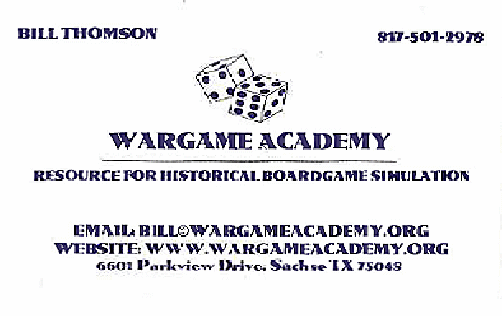BATTLE OF THE BULGE B81 Q&A
updated 031118
Taken for Web Grognards; NB submitted by John Kula (kula@telus.net)
on behalf of the Strategy Gaming Society (http://www.boardgamegeek.com/~sgs),
originally collected by Andrew Webber (gbm@wwwebbers.com)
Others from The General submitted by same John Kula
BULGE'81
- 6.8 If a unit leaves the board during movement or during advance after combat,
does the opposing playeer receive Victory Points for unit elimination? A.
No.
- 11.5.1 The rule states that supply status is checked when Allied FPF
support is being placed. Does this mean that a "supply determination"
which is done during the Allied Supply Phase must also be made during the
Allied Support Phase? A. No. Supply status is determined
only during the Supply Phase. The term in Rule 11.5.1 simply means that the
Allied player must check to see is an artillery unit has an isolation marker
on top of it (Rule 13.1) before the corresponding FPF support marker is placed.
For simplicity and clarity, delete the second sentence of Rule 11.5.1.
- 35.1, 46.4.1 and 46.4.2 Suppose German units retreat off the board via an
arrow, fulfilling German Victory Conditions and causing British units to divert
to Antwerp; do they count as units eliminated for Allied point count? A.
Yes.
- 13.2 and 13.3 Rule 13.2 states that isolated artillery units attack at half-strength
and rule 13.3 states that isolated artillery units may not provide fire support.
Which is correct? A. Both are correct. Direct attack or defense
against adjacent enemy units is distinct from fire support. See rule 11.1.
- 14.1.2.3 Since fire support and direct attacks are not the same, does this
mean that German corps artillery may move at one-quarter point road movement
rate and then participate in an attack against adjacent Allied units? A.
Yes.
- 14.1.1.1 What size boots do Nebelwerfers wear? [Published verbatim.] A.
150's, 170's or 21O's?
- 14.1.2.2 and 42.6.2 If a commando is not recognized by an Allied infantry
unit moving from the north edge into Eupen, how is the movement reduced for
the Allied unit? A. This answer has two possibilities:
- 1) If the Allied unit does not enter enemy ZOC, the movement rate is
figured as such: 1/4 plus 1/4 to reach Eupen, at which point 3 and 1/2
movement points (or 14 road movement points) remain, of which half are
lost (i.e., seven road movement points); or
- 2) If the Allied unit does intend to enter an enemy ZOC, the movement
rate is figured as such: 1/3 plus 1/3 to reach Eupen; at this point, 3
and 1/3 movement points (or 10 road movement points) remain of which half
are lost (i.e., five road movement points).
- 14.2.6 and 14.2.8 If an armor unit moves through a river headwaters
hex, then along the river, and finally ends its turn on the river, does the
owning player have to declare which side of the river the unit occupies? A.
Yes; players should always know which bank of a river an amored unit
occupies. As a player aid, armor units should be faced so that the top edge
ofthe counter points to the side of the river that the unit occupies. For
example, a German panzer unit on the east bank of the Salm (hex FF14) would
be read upside down by the German player sitting at the east edge of the mapboard.
- 23.5.5 In the example of "Engagement" (pg. 20-21), the Allied
5-4 and 4-4 stand fast after the German turn. But during Allied attacks, an
Allied unit advances adjacent to one of the German units (say, to JJ26). In
the chain reaction that ends the engagement, are the Allied 5-4 and 4-4 immediately
required to counterattack? A. No. The choice to "standfast"
is made after movement, but before the Allied combat phase (23.3). The engagements
end and, if possible, the Germans are free to move away on their turn (23.5.5).
In effect, the Allied advance has changed the "Engaged" result into
a "Contact" result at the end of the turn.
Please send comments and corrections via to Wargame
Academy
Go to the Wargame
Academy main page


![]()
![]()